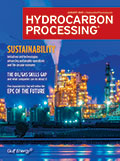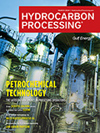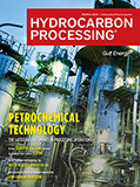
January 2020
Special Focus: Sustainability
Significant change is coming to the hydrocarbons industry. Up to 43% of the global conventional polymer production expected by 2040 may disappear due to circular economy (CE) initiatives. In addition, due to the growth in wind turbines and solar panels, and in lightweight composite materials in cars and planes, advanced materials waste is just beginning.
Since the 1970s, Brazil has been a world reference in automotive biofuels, especially bioethanol produced from sugarcane. In 1973, the Organization of the Petroleum Exporting Countries (OPEC) forced a sharp rise in oil prices, triggering a massive slowdown in the country’s economic growth, which had been going through what was dubbed the “economic miracle,” with growth at an average of 12% of GDP. This study gives an overview of the biofuel sector in Brazil, along with the main business challenges and opportunities in this area.
Ammonia is well known as a fertilizer. However, it is also a potential carbon-free fuel and an excellent solution for storage of renewable electricity, especially if the syngas needed for producing the ammonia is made by electrolysis.
As China’s largest integrated refinery, Sinopec’s Zhenhai Refining & Chemical Co. (ZRCC) plant can process approximately 23 MM metric tpy of crude oil. The plant produces more than 50 fuel and chemical products, including different grades of gasoline, jet and diesel fuels, asphalt and polypropylene plastics, as well as more than 1 MM metric tpy of ethylene. The latter generates spent caustic, one of the world’s most toxic wastewaters.
Process Optimization
In a typical xylene loop, C<sub>8</sub> aromatics are fractionated out of a heavy reformate C<sub>8</sub>+ aromatics stream and collected in the xylene column overhead. Then, paraxylene (PX) from the C<sub>8</sub> aromatics stream is recovered as product—usually by an adsorption or crystallization process—in the PX recovery section.
Hydrocrackers are key refinery units that convert heavy feed components into valuable lighter products. The profitability of these units is directly related to this conversion level. Conversion reactions take place in a nearly pure hydrogen environment, with the help of selective catalysts, under high pressure and high temperature. The products of the unit are separated in the fractionator section. Unconverted oil taken from the fractionator bottoms reveals the conversion performance of the unit.
RAM refers to reliability, availability and maintainability analysis. The RAM model uses discrete event simulation (DES) software and provides a quantitative assessment of the performance of an industrial plant. This article discusses the use of RAM analysis on petroleum refinery projects to select an optimum process configuration and associated storage requirements.
Catalysts
Hellenic Petroleum S.A.’s Aspropyrgos refinery is located near Athens, Greece. It has a total refining capacity of approximately 7.5 MMtpy and a Nelson complexity index of 9.7. The refinery was built in 1958 and has undergone several upgrades, including the installation of a fluid catalytic cracking unit (FCCU).
Heat Transfer
Process engineers strive to recover as much energy as is practically possible from the available process and utility streams within the constraint of the plant. To achieve this goal, traditional—and sometimes non-traditional—methods are utilized. In a steam cracker, light olefins are considered the highest-value products, and utilizing “cold energy,”
Valves, Pumps and Turbomachinery
On December 15, 2002, an anomalous event occurred in a steam turbine of Unit 2 at the South Texas Project Electric Generating Station, a pressurized water reactor (PWR) nuclear reactor near Bay City, Texas. The ensuing investigation concluded that a blade was ejected from a low-pressure stage, and detailed inspections revealed additional cracked blades in several stages.
Process Controls, Instrumentation and Automation
One of the most common and important building blocks in the petrochemical industry is ethylene, constituting a huge and fast-growing worldwide industry. Ethylene is an intermediate chemical used to manufacture many commercial products—approximately 200 MMt will be produced in 2020.
Columns
An emerging topic along the entire oil and gas value chain is the move toward <i>sustainability.</i> Each company has a somewhat different definition of what sustainability means to its operations.
We can only guess how many reliability conferences we have attended since accepting job offers in the refining or chemical processing industries. In my case, starting in 1965, it is somewhere between 60 and 80. If, in each of these conferences I listened to six presentations, the number of sessions attended is perhaps 400.
Let’s face it, alarm management is a fully mature body of knowledge. Since the mid-1990s, industry has improved thousands of alarm systems, transforming them from overloaded nuisances to valuable operator tools for abnormal situation detection and response.
The skills gap is not a new phenomenon for the oil and gas sector. An aging workforce and increased competition for tomorrow’s technical talent have left the industry nervous about its future. On the heels of the 2019 Global Energy Talent Index (GETI), a panel of experts came together to discuss the sector’s ongoing struggle with the skills gap and what oil and gas/energy companies can do about it.
The size of the global flowmeter market has followed the upward and downward fluctuations in oil prices and is now on an upward trajectory, according to a new study by Flow Research that provides total global market shares of the major suppliers of each flowmeter technology (except sonar and optical) by 2018 revenues.
Trends and Resources
Over the past several years, investments in petrochemicals capacity additions have skyrocketed. Hundreds of billions of dollars have and will be invested in additional petrochemicals units and complexes.
The state of the global engineering, procurement and construction (EPC) industry can accurately be described as “challenging.” Operating in an environment of volatile, uncertain, complex and ambiguous conditions, EPC firms are facing unsustainable levels of stress.
Product markets lost ground as refinery intakes recovered following peak refinery maintenance season, leading to higher product availability.
<i>Hydrocarbon Processing’s</i> Construction Boxscore Database is tracking more than 1,430 projects around the world, representing nearly $1.9 T in capital expenditures.
Equatorial Guinea plans to invest $1 B to build several energy projects, including the construction of two new refineries, each with a capacity of 30,000 bpd–40,000 bpd, as well as oil storage facilities, a methanol-to-gasoline plant and an LNG expansion project.
Honeywell is developing a OneWireless™ IoT Module for the next generation of Cisco’s industrial access points, the Cisco Catalyst IW6300 Heavy Duty Series Access Point. The Honeywell and Cisco technologies will form the backbone of Honeywell’s OneWireless Network.
The Valve Manufacturers Association of America (VMA) has named Heather Rhoderick as President. She will succeed William “Bill” Sandler, who retired this year after a 40-yr tenure with the organization.

- Brazil's Timbro to export 40% more sugar, enter ethanol market in 2024 4/24
- LG Chem denies report it will merge naphtha cracker business with Lotte Chemical 4/24
- Crude and gasoline stocks fell, distillate stocks rose last week, EIA says 4/24
- INERATEC secures state-of-the-art catalysts from Sasol for the production of sustainable e-fuels 4/24
- JX to join forces with Sumitomo at large scale SAF/BECCS project in Louisiana (U.S.) 4/24
- WestJet buys first Canadian-supplied SAF by Shell Aviation 4/23




